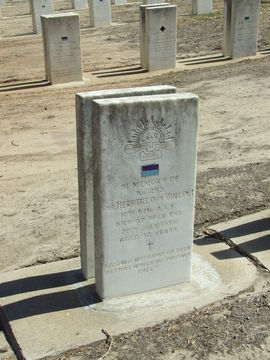
4271
VINCENT, Herbert Reginald
| Service Numbers: | 253, 8248 |
|---|---|
| Enlisted: | Not yet discovered |
| Last Rank: | Sapper |
| Last Unit: | Tunnelling Companies |
| Born: | Not yet discovered |
| Home Town: | Not yet discovered |
| Schooling: | Not yet discovered |
| Occupation: | Engine Fitter |
| Died: | Broken Hill, 20 July 1956, cause of death not yet discovered, age not yet discovered |
| Cemetery: |
West Terrace Cemetery (AIF Section) Section: KO, Road: 12, Site No: 75 |
| Memorials: | Leonora Road Board District Roll of Honor |
World War 1 Service
| 20 Oct 1914: | Involvement Private, 253, 10th Infantry Battalion, --- :embarkation_roll: roll_number: '10' embarkation_place: Adelaide embarkation_ship: HMAT Ascanius embarkation_ship_number: A11 public_note: '' | |
|---|---|---|
| 20 Oct 1914: | Embarked Private, 253, 10th Infantry Battalion, HMAT Ascanius, Adelaide | |
| 26 Nov 1917: | Embarked Sapper, 8248, Tunnelling Companies, SS Indarra, Melbourne | |
| 26 Nov 1917: | Involvement Sapper, 8248, Tunnelling Companies, --- :embarkation_roll: roll_number: '6' embarkation_place: Melbourne embarkation_ship: SS Indarra embarkation_ship_number: '' public_note: '' |
Help us honour Herbert Reginald Vincent's service by contributing information, stories, and images so that they can be preserved for future generations.
Add my storyBiography contributed by St Ignatius' College
Herbert Reginald Vincent was a Private who fought in the WW1 between 1914 – 1918. He was born in 1887 in the town of Moree, New South Wales, child of Mary Jessie Vincent and Arthur Edward Vincent. He had six siblings. His mother was listed his next of kin as his father died in Armidale NSW 1911. Before the war he worked as a miner and during the war he married Susanna Pedler.
Herbert Reginald Vincent took the oath on the 24th of August 1914. He commenced his basic training with B Coy and was moved to C Coy two days later in the rank of Private. Over 30,000 men trained at Mitcham camp from 1915 to 1918, which is now known Colonel Light Gardens.
During the training they followed a very strict routine. They had to get up at 6 o’clock and finish all their morning activities like washing, shaving, folding blankets, cleaning out tents and have breakfast by 7:30 when the inspection parade started. Most of early training was around physical activities and fitness, preparing the soldiers to be physically and mentally strong. The training officially started on the 3rd of September revolving around activities like marching, infantry tactics, field craft, cleanliness and care of the feet and night and day visual training.
On the 20th of October the 10th Battalion entrained at Morphettville Railway Station bound for their ship HMAT A11 Ascanius. Many citizens arrived at the train station to say goodbye to the soldiers by waving flags, handkerchiefs, and scarfs. The 10th battalion did an outstanding job in the Gallipoli campaign, playing a key role in the major Turkish counterattack on the 19th of May. Herbert served two and a half years with the 10th Battalion and was wounded in action after suffering a gunshot wound to his foot on the 30th of April 1915 in Gallipoli. His next of kin was advised on the 9th of May 1915.
His mother was very anxious due to the bad news, and Vincent's service record notes that she wanted to go to Alexandria to nurse him. He then rejoined from being wounded on the 12th of June 1915. He was transferred to the Divisional Artillery Column and was taken on strength as a Gunner in November. He was diagnosed with a heart condition in May 1916 and was invalided to Australia and discharged on the 5th of July 1916.
Herbert was re enlisted on the 3rd of July 1917 with the Tunnelling reinforcements, most likely due to his previous occupation as a miner. Their expertise was used in the tunnel war. Tunnelling companies were formed within the Engineering corps from the Mining corps. The tunnelling units were used in both defensive and offensive mining, including placing, and maintaining under enemy lines, construction of deep dugouts, subways, and underground chambers for medical services.
On the 14th of August 1917 he was promoted to Provisional Corporal in the C coy Tunnelling Reinforcements Unit. but on August 25th he was sent to isolation camp in Ascot Vale. Due to outbreaks of serious illnesses, there was a need for isolation camps where anyone who had been in contact with a sick person would be removed for observation. Men would normally spend around three weeks in the camp, and they were having daily throat swabs. This would sometimes mean that they would miss the embarkation of their battalion. He remained in the isolation camp until the 17th of October when he returned to Bendigo Victoria as an Acting Corporal. He embarked from Melbourne, Victoria, on board SS Indarra on 26 November 1917
Herbert fell ill with bronchitis on the 21st of June 1918 and was taken to the 15th of Aust Field Ambulance then to the 61st Casualty Clearing station and then later on the 1st Aust General Hospital.
On the 4th of November he was part of the Overseas Training Brigade at Deverill and was there until the 11th of November when the war ended.
Herbert Reginald Vincent returned to Australia on the 23rd of July 1919 by embarking H.T. Suevic. The ship was carrying 1400 Australian troops and arrived at Semaphore. They were planned to disembark on Saturday but due to the bad weather conditions it wasn’t safe to land.
On 20th of July 1956 he passed away at the age of sixty nine. His place of burial is at West Terrace Cemetery, South Australia.









